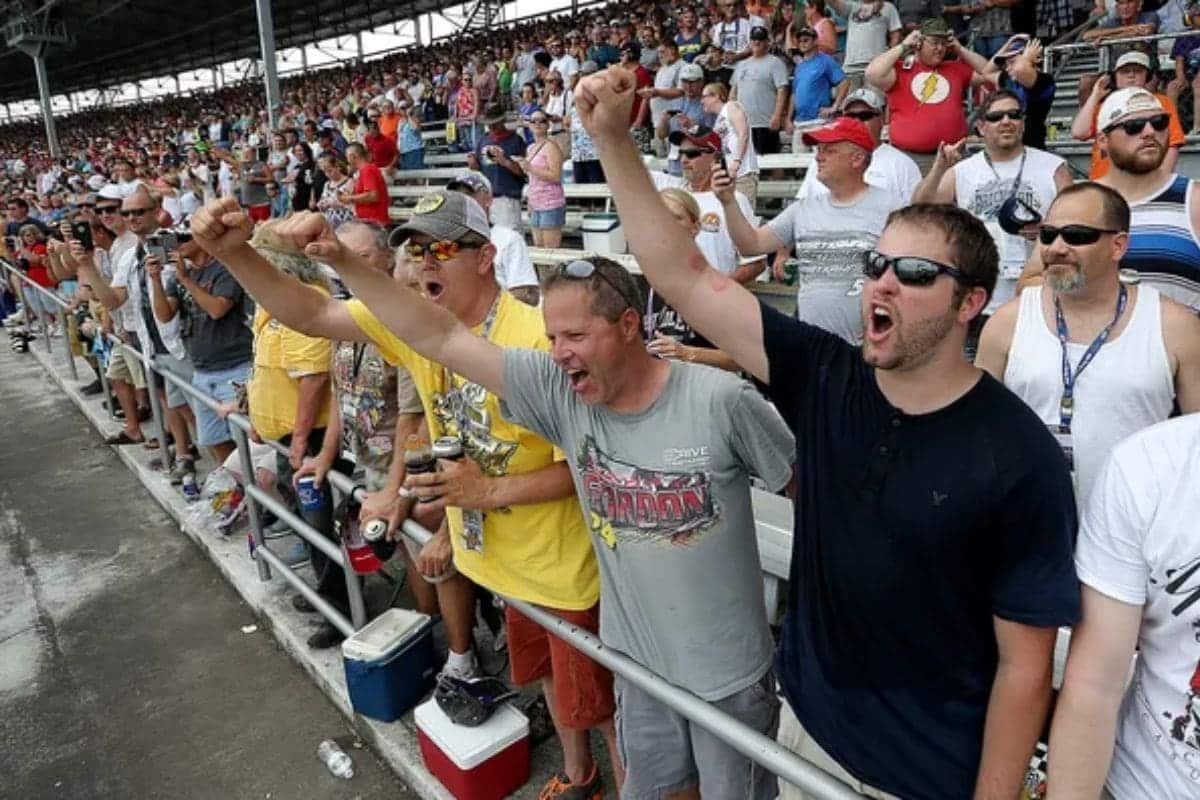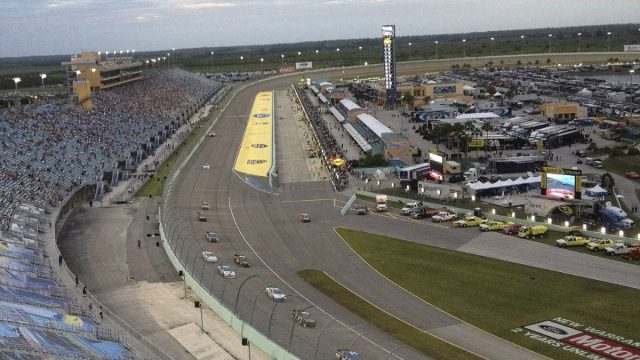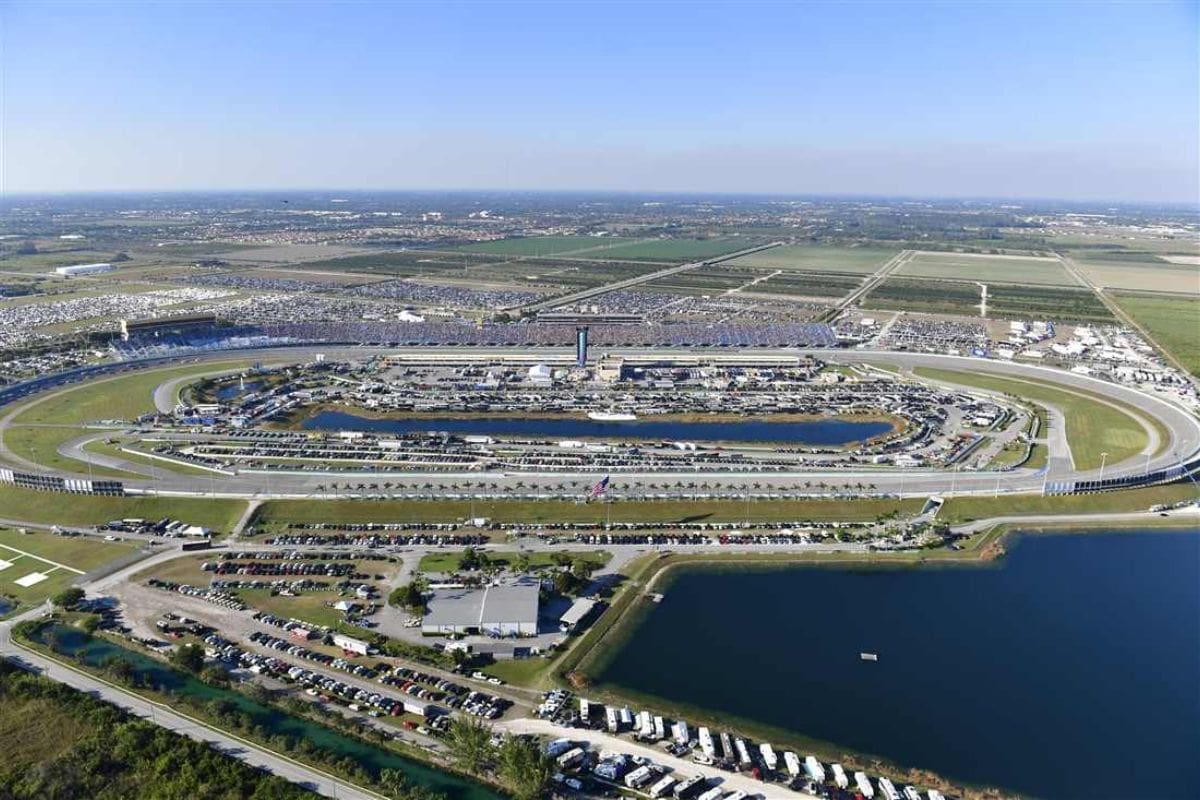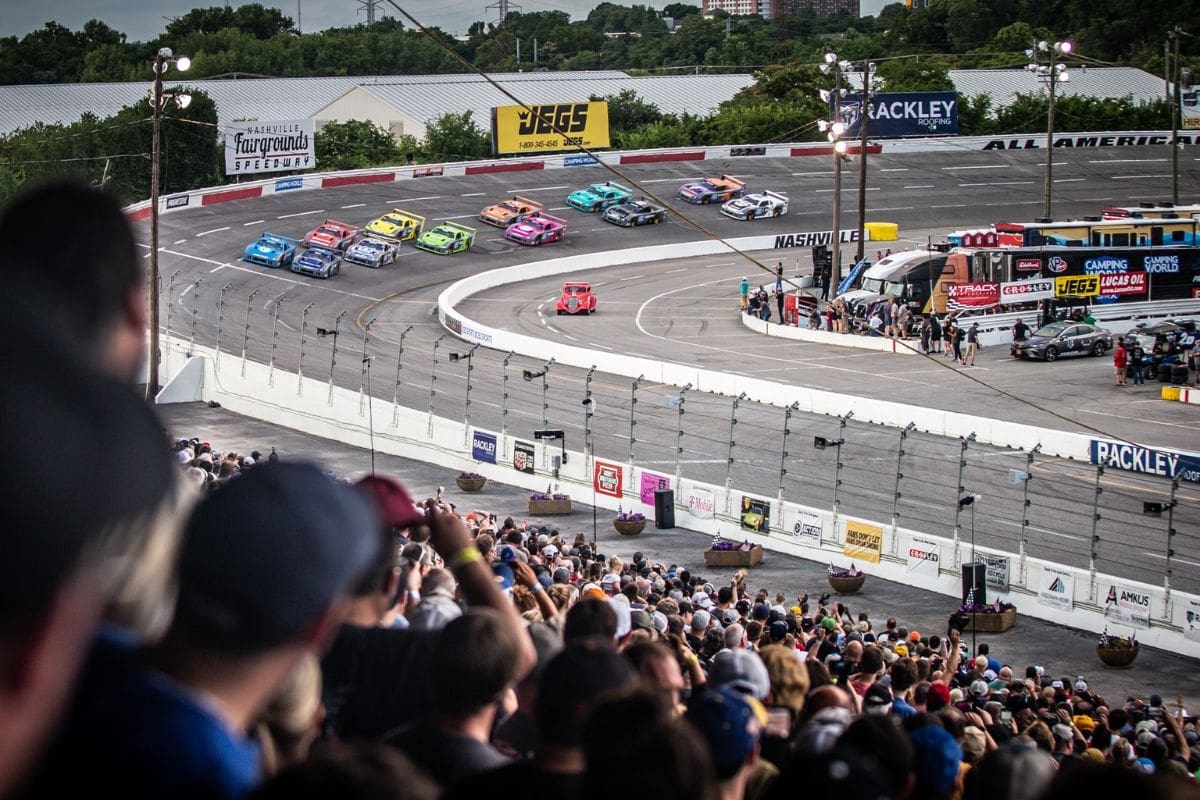Homestead-Miami Cut From Playoff Lineup: NASCAR’s decision to exclude Homestead-Miami Speedway from the 2025 playoff lineup signifies a bold strategic shift. The announcement, revealed by journalists Jeff Gluck and Jordon Bianchi, moves the race to March, sparking mixed reactions. While the track’s rich history of dramatic finishes is well-regarded, the decision aims to diversify playoff venues and address weather challenges. This change will impact teams and drivers who have excelled at Homestead, while also affecting local businesses and tourism. The introduction of new tracks like New Hampshire and Darlington Raceway will reshape playoff strategies and race dynamics. Understanding the full implications of this move reveals NASCAR’s evolving strategic objectives.
Key Highlights
- Homestead-Miami Speedway is being removed from the 2025 playoff lineup, moving to an earlier date in March.
- The decision aims to address weather challenges and optimize NASCAR’s racing schedule.
- New tracks like New Hampshire and Worldwide Technology Raceway are added to the 2025 playoff lineup.
- The move raises concerns about economic impacts on local businesses and tourism in Homestead.
- Fans and insiders express disappointment, viewing Homestead-Miami as a cornerstone of the playoff schedule.
Introduction and Shocking Revelation
In a move that has sent shockwaves through the NASCAR community, The Athletic has revealed that the sanctioning body is planning to remove Homestead-Miami Speedway from the playoff lineup for the 2025 season. This decision marks a significant departure from tradition, as the Homestead-Miami Speedway has been a staple in the NASCAR playoff structure for years, often serving as a critical venue for championship-deciding races.
Homestead-Miami Speedway, located in Homestead, Florida, has long been celebrated for its unique characteristics, including its progressive banking and multi-groove racing, which offer drivers a variety of racing lines and strategies. The track’s history of producing dramatic finishes and its role in determining the NASCAR Cup Series champion have solidified its reputation as a fan and driver favorite. Hence, its removal from the playoff lineup is not just a logistical change but a profound shift in the landscape of NASCAR racing.
From an analytical perspective, the decision to exclude Homestead-Miami raises several questions. To begin with, what criteria were used to determine which tracks would be cut from the playoff schedule? The choice suggests a strategic pivot by NASCAR, potentially aimed at revitalizing the playoff dynamics or responding to fan and stakeholder feedback.
Moreover, this move could have significant implications for teams and drivers who have historically excelled at this venue, altering their playoff strategies and preparations.
Furthermore, this change may impact the broader economic ecosystem surrounding the race, including local businesses and tourism in Homestead, Florida. The effects of such a decision highlight the importance of strategic planning and stakeholder engagement in the evolving world of NASCAR.
Announcement and Reactions
The announcement of Homestead-Miami Speedway’s removal from the 2025 playoff lineup, revealed by journalists Jeff Gluck and Jordon Bianchi on ‘The Teardown,’ has sparked a wave of reactions across the NASCAR community. The decision to reschedule the iconic track to an earlier date in March has left many stakeholders analyzing the implications of this substantial shift.
The timing of the announcement, strategically disclosed during an episode of ‘The Teardown,’ suggests an intentional approach by NASCAR to prepare fans and teams for the upcoming changes.
“We know about Atlanta. That’s already been announced moving from starting the playoffs to mid-summer. Two other tracks that the Athletic has learned will be moving out of the playoffs; Watkins Glen and Homestead. No homestead in the playoffs; supposedly moving… I’ve been told… to early March or mid-March”- jeff gluck ,jordon bianchi on The Teardown
Jeff Gluck and Jordon Bianchi noted that Homestead-Miami, alongside Watkins Glen and Atlanta, will no longer be part of the high-stakes playoff series, with Homestead likely moving to early or mid-March. This move raises questions about the underlying rationale and the broader impact on the competitive landscape of the sport.
Industry reactions have been mixed. Some view the change as a bold step towards diversifying the playoff venues and potentially enhancing the excitement of the early season. The shift could theoretically spread the intensity of competition more evenly across the calendar year, potentially drawing new audiences during the traditionally less intense early months. However, the historical significance of Homestead-Miami, often seen as a perfect playoff track, cannot be overstated.
Analysts have pointed out that the change may affect team strategies and preparations, as the characteristics of Homestead-Miami’s track have traditionally played a significant role in determining playoff outcomes. The move to March could alter the dynamics of car setups and race strategies, compelling teams to adapt to a different racing context.
Fan and Insider Disappointment
Amid the surprising announcement of Homestead-Miami Speedway’s exclusion from the 2025 playoff lineup, fans and insiders both are grappling with disappointment and confusion. This decision has reverberated through the NASCAR community, eliciting strong reactions from stakeholders who view Homestead-Miami as a cornerstone of the playoff schedule. The unexpected nature of the announcement has only exacerbated the discontent, leaving many to question the motivations behind such a significant change.
The absence of Homestead, a track lauded for its competitive racing and unique characteristics, has left a void in the heart of many enthusiasts. Fans have voiced their dismay across different platforms, arguing that the track’s removal undermines the integrity and excitement of the playoffs. The sentiment among the fanbase is that Homestead-Miami has consistently delivered thrilling races, making its exclusion a perplexing and unwelcome development.
Even within the inner circles of NASCAR, the decision has sparked controversy. Renowned spotter Brett Griffin, among others, has expressed his astonishment, highlighting the track’s crucial role in the sport. Insiders are struggling to find a justifiable rationale for this move, given Homestead-Miami’s reputation as one of the best tracks on the schedule. The lack of an updated 2025 schedule further fuels speculation and frustration, as stakeholders await clarity on NASCAR’s strategic direction.
“I think I’m okay with the playoffs changing tracks, but this smells like a fart in a sleeping bag. This just does not get me excited.”
“It stinks.” – Grifin
This wave of disappointment emphasizes the broader implications of altering the playoff lineup. The decision has not only disrupted fan engagement but also shaken confidence within the NASCAR community. As the sport navigates this contentious change, it faces the challenge of reconciling its bold move with the expectations and loyalties of its dedicated followers.

Impact and Changes in Playoff Lineup
Significant shifts in the NASCAR playoff lineup for 2025 introduce new dynamics and uncertainties, reshaping the competitive landscape for teams and drivers alike. The inclusion of new tracks and the removal of long-standing staples like Homestead-Miami have profound implications for strategy, performance, and fan engagement.
Firstly, New Hampshire’s inclusion in the playoff roster brings a fresh challenge to the drivers and an enthusiastic fanbase into the high-stakes environment of the playoffs. Known for its unique ‘Magic Mile’ layout, New Hampshire demands precise handling and strategic tire management, which could benefit teams with superior engineering expertise.
The Worldwide Technology Raceway, another new entrant, adds a layer of complexity with its diverse track characteristics. The oval track, featuring varying degrees of banking in the corners, will test drivers’ adaptability and the versatility of their cars. This venue introduces a variable that could disrupt traditional powerhouses, offering an opportunity for underdog teams to shine.
Darlington Raceway’s return to the playoff schedule, after a hiatus due to scheduling conflicts, reintroduces its famously challenging ‘Lady in Black’ track. The abrasive surface and tight corners of Darlington are notorious for wearing down tires and demanding high levels of driver skill and patience. Teams and drivers with a historical affinity for this track will find renewed opportunities to utilize their experience.
Conversely, the removal of Homestead-Miami is a significant loss for drivers like Kyle Larson, Christopher Bell, and Tyler Reddick, who have demonstrated strong performances there. This change forces these drivers to adjust their playoff strategies, potentially diminishing their competitive edge.
Reasoning Behind the Decision
Understanding the rationale behind the removal of Homestead-Miami from the playoff lineup requires examining NASCAR’s strategic adjustments to accommodate weather-related challenges and optimize the racing schedule. Homestead-Miami, a premier 1.5-mile oval track in South Florida, has been a staple in the NASCAR playoff scene, hosting the championship-deciding race from 2002 to 2019. Its sudden exclusion from the playoff roster for the upcoming season has left many fans and analysts perplexed. However, the decision is rooted in practical considerations aimed at improving the race experience and logistical efficiency.
Jordon Bianchi, a reputable source within the NASCAR community, elucidates that the reallocation of Homestead-Miami to the start of the season serves an important purpose. With Fontana removed from the schedule, there is a scarcity of early-season races held in warm climates. Bianchi explains,
“I’ve been told that it’s because they need another warm weather date. Fontana, as you know, is off the schedule. You only have two west-coast races now. You do not have a lot of races at the beginning of the year where weather isn’t going to be an issue or shouldn’t be an issue.” – Bianchi
Incorporating Homestead-Miami into the early part of the season mitigates the risk of weather-related disruptions, ensuring a smoother start to the NASCAR calendar. This strategic repositioning allows NASCAR to utilize the favorable South Floridian climate, providing a more consistent and predictable environment for both drivers and fans. Consequently, while the move may initially disappoint some, it highlights NASCAR’s commitment to enhancing the integrity and enjoyment of the sport.
News in Brief: Homestead-Miami Cut From Playoff Lineup
The exclusion of Homestead-Miami from the NASCAR playoff lineup marks a significant shift in the series’ structure. This decision, met with considerable disappointment from fans and industry insiders, reflects strategic adjustments aimed at revitalizing the competition.
The impact on the playoff lineup is substantial, necessitating adaptations from teams and drivers as well. The reasoning behind this bold move highlights NASCAR’s commitment to evolving its format to improve excitement, competitiveness, and engagement in future seasons.
Our Reader’s Queries
Q. How long is the Nascar race in Homestead?
A. The NASCAR Cup Series race at Homestead-Miami Speedway takes place at the Homestead–Miami Speedway in Homestead, Florida. Spanning 267 laps, the race covers 400.5 miles (644.542 km). Christopher Bell enters as the defending champion of the event.
Q. Who won NASCAR Homestead race?
A. Christopher Bell secured victory at Homestead, holding on to clinch a spot in the Championship 4.
Q. Who holds the most career wins at Homestead-Miami Speedway?
A. Tony Stewart, Greg Biffle, and Denny Hamlin stand as the most successful drivers in NASCAR history at Homestead, each boasting three victories at the track. Stewart triumphed in the first two Cup Series races at the venue and again in 2011, while Biffle achieved a remarkable three consecutive wins from 2004 to 2006.
ALSO READ: Understanding NASCAR Playoff Waiver: Key Details Explained


